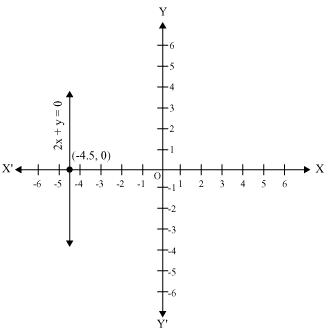Exercise 4.1 : Solutions of Questions on Page Number : 68
Q1 : The cost of a notebook is twice the cost of a pen. Write a linear equation in two variables to represent this statement.
(Take the cost of a notebook to be Rs x and that of a pen to be Rs y.)
Answer :
Let the cost of a notebook and a pen be x and y respectively.
Cost of notebook = 2 * Cost of pen
x = 2y
x – 2y = 0
Q2 : Express the following linear equations in the form ax + by + c = 0 and indicate the values of a, b, c in each case:
(i) ![]() (ii)
(ii)![]() (iii) – 2x + 3 y = 6
(iii) – 2x + 3 y = 6
(iv) x = 3y (v) 2x = – 5y (vi) 3x + 2 = 0
(vii) y – 2 = 0 (viii) 5 = 2x
Answer :
(i)![]()
![]()
= 0
Comparing this equation with ax + by + c = 0,
a = 2, b = 3,![]()
(ii)![]()
Comparing this equation with ax + by + c = 0,
a = 1, b =![]() ,c = – 10
,c = – 10
(iii) – 2x + 3 y = 6
– 2x + 3 y – 6 = 0
Comparing this equation with ax + by + c = 0,
a = – 2, b = 3, c = – 6
(iv) x = 3y
1x – 3y + 0 = 0
Comparing this equation with ax + by + c = 0,
a = 1, b = – 3, c = 0
(v) 2x = – 5y
2x + 5y + 0 = 0
Comparing this equation with ax + by + c = 0,
a = 2, b = 5, c = 0
(vi) 3x + 2 = 0
3x + 0.y + 2 = 0
Comparing this equation with ax + by + c = 0,
a = 3, b = 0, c = 2
(vii) y – 2 = 0
0.x + 1.y – 2 = 0
Comparing this equation with ax + by + c = 0,
a = 0, b = 1, c = – 2
(vii) 5 = 2x
– 2x + 0.y + 5 = 0
Comparing this equation with ax + by + c = 0,
a = – 2, b = 0, c = 5
Exercise 4.2 : Solutions of Questions on Page Number : 70
Q1 : Which one of the following options is true, and why?
y = 3x + 5 has
(i) a unique solution, (ii) only two solutions, (iii) infinitely many solutions
Answer :
y = 3x + 5 is a linear equation in two variables and it has infinite possible solutions. As for every value of x, there will be a value of y satisfying the above equation and vice-versa.
Hence, the correct answer is (iii).
Q2 : Write four solutions for each of the following equations:
(i) 2x + y = 7 (ii) πx + y = 9 (iii) x = 4y
Answer :
(i) 2x + y = 7
For x = 0,
2(0) + y = 7
⇒ y = 7
Therefore, (0, 7) is a solution of this equation.
For x = 1,
2(1) + y = 7
⇒ y = 5
Therefore, (1, 5) is a solution of this equation.
For x = – 1,
2( – 1) + y = 7
⇒ y = 9
Therefore, ( – 1, 9) is a solution of this equation.
For x = 2,
2(2) + y = 7
⇒y = 3
Therefore, (2, 3) is a solution of this equation.
(ii) πx + y = 9
For x = 0,
π(0) + y = 9
⇒ y = 9
Therefore, (0, 9) is a solution of this equation.
For x = 1,
π(1) + y = 9
⇒y = 9 – π
Therefore, (1, 9 – π) is a solution of this equation.
For x = 2,
π(2) + y = 9
⇒ y = 9 – 2π
Therefore, (2, 9 – 2π) is a solution of this equation.
For x = – 1,
π( – 1) + y = 9
⇒ y = 9 + π
⇒ ( – 1, 9 + π) is a solution of this equation.
(iii) x = 4y
For x = 0,
0 = 4y
⇒ y = 0
Therefore, (0, 0) is a solution of this equation.
For y = 1,
x = 4(1) = 4
Therefore, (4, 1) is a solution of this equation.
For y = – 1,
x = 4( – 1)
⇒ x = – 4
Therefore, ( – 4, – 1) is a solution of this equation.
For x = 2,
2 = 4y
⇒![]()
Therefore![]() , is a solution of this equation.
, is a solution of this equation.
Q3 : Check which of the following are solutions of the equation x – 2y = 4 and which are not:
(i) (0, 2 (ii) (2, 0) (iii) (4, 0)
(iv) ![]() (v) (1, 1)
(v) (1, 1)
Answer :
(i) (0, 2)
Putting x = 0 and y = 2 in the L.H.S of the given equation,
x – 2y = 0 – 2×2 = – 4 ≠ 4
L.H.S ≠ R.H.S
Therefore, (0, 2) is not a solution of this equation.
(ii) (2, 0)
Putting x = 2 and y = 0 in the L.H.S of the given equation,
x – 2y = 2 – 2 × 0 = 2 ≠ 4
L.H.S ≠ R.H.S
Therefore, (2, 0) is not a solution of this equation.
(iii) (4, 0)
Putting x = 4 and y = 0 in the L.H.S of the given equation,
x – 2y = 4 – 2(0)
= 4 = R.H.S
Therefore, (4, 0) is a solution of this equation.
(iv)![]()
Putting ![]() and
and![]() in the L.H.S of the given equation,
in the L.H.S of the given equation,

L.H.S ≠ R.H.S
Therefore, is not a solution of this equation.
(v) (1, 1)
Putting x = 1 and y = 1 in the L.H.S of the given equation,
x – 2y = 1 – 2(1) = 1 – 2 = – 1 ≠ 4
L.H.S ≠ R.H.S
Therefore, (1, 1) is not a solution of this equation.
Q4 : Find the value of k, if x = 2, y = 1 is a solution of the equation 2x + 3y = k.
Answer :
Putting x = 2 and y = 1 in the given equation,
2x + 3y = k
⇒ 2(2) + 3(1) = k
⇒ 4 + 3 = k
⇒ k = 7
Therefore, the value of k is 7
Exercise 4.3 : Solutions of Questions on Page Number : 74
Q1 : Draw the graph of each of the following linear equations in two variables:
(i)![]() (ii)
(ii)![]() (iii) y = 3x (iv) 3 = 2x + y
(iii) y = 3x (iv) 3 = 2x + y
Answer :
(i)![]()
It can be observed that x = 0, y = 4 and x = 4, y = 0 are solutions of the above equation. Therefore, the solution table is as follows.
|
x |
0 |
4 |
|
y |
4 |
0 |
The graph of this equation is constructed as follows.
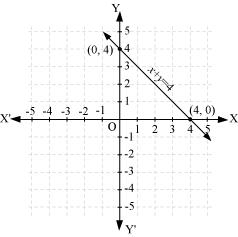
(ii)![]()
It can be observed that x = 4, y = 2 and x = 2, y = 0 are solutions of the above equation. Therefore, the solution table is as follows.
|
x |
4 |
2 |
|
y |
2 |
0 |
The graph of the above equation is constructed as follows.
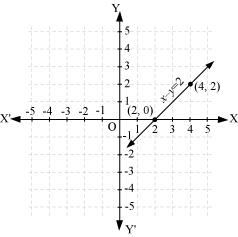
(iii) y = 3x
It can be observed that x = – 1, y = – 3 and x = 1, y = 3 are solutions of the above equation. Therefore, the solution table is as follows.
|
x |
-1 |
1 |
|
y |
-3 |
3 |
The graph of the above equation is constructed as follows.
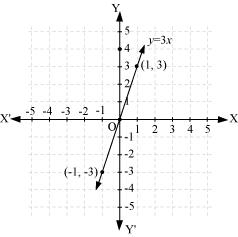
(iv) 3 = 2x + y
It can be observed that x = 0, y = 3 and x = 1, y = 1 are solutions of the above equation. Therefore, the solution table is as follows.
|
x |
0 |
1 |
|
y |
3 |
1 |
The graph of this equation is constructed as follows.
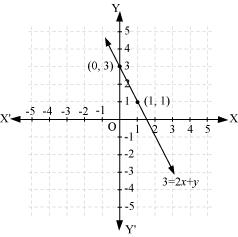
Q2 : Give the equations of two lines passing through (2, 14). How many more such lines are there, and why?
Answer :
It can be observed that point (2, 14) satisfies the equation 7x – y = 0 and
x – y + 12 = 0.
Therefore, 7x – y = 0 and x – y + 12 = 0 are two lines passing through point (2, 14).
As it is known that through one point, infinite number of lines can pass through, therefore, there are infinite lines of such type passing through the given point.
Q3 : If the point (3, 4) lies on the graph of the equation 3y = ax + 7, find the value of a.
Answer :
Putting x = 3 and y = 4 in the given equation,
3y = ax + 7
3 (4) = a (3) + 7
5 = 3a
![]()
Q4 : The taxi fare in a city is as follows: For the first kilometre, the fares is Rs 8 and for the subsequent distance it is Rs 5 per km. Taking the distance covered as x km and total fare as Rs y, write a linear equation for this information, and draw its graph.
Answer :
Total distance covered = x km
Fare for 1st kilometre = Rs 8
Fare for the rest of the distance = Rs (x – 1) 5
Total fare = Rs [8 + (x – 1) 5]
y = 8 + 5x – 5
y = 5x + 3
5x – y + 3 = 0
It can be observed that point (0, 3) and![]() satisfies the above equation. Therefore, these are the solutions of this equation.
satisfies the above equation. Therefore, these are the solutions of this equation.
|
x |
0 |
|
|
y |
3 |
0 |
The graph of this equation is constructed as follows.

Here, it can be seen that variable x and y are representing the distance covered and the fare paid for that distance respectively and these quantities may not be negative. Hence, only those values of x and y which are lying in the 1st quadrant will be considered.
Q5 : From the choices given below, choose the equation whose graphs are given in the given figures.
|
For the first figure |
For the second figure |
||
|
(i) |
y = x |
(i) |
y = x +2 |
|
(ii) |
x + y = 0 |
(ii) |
y = x |
|
(iii) |
y = 2x |
(iii) |
y = |
|
(iv) |
2 + 3y = 7x |
(iv) |
x + 2y = 6 |
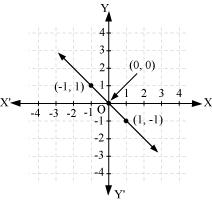
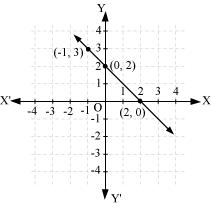
Answer :

Points on the given line are (-1, 1), (0, 0), and (1, -1).
It can be observed that the coordinates of the points of the graph satisfy the equation x + y = 0. Therefore, x + y = 0 is the equation corresponding to the graph as shown in the first figure.
Hence, (ii) is the correct answer.

Points on the given line are (-1, 3), (0, 2), and (2, 0). It can be observed that the coordinates of the points of the graph satisfy the equation y = – x + 2.
Therefore, y = – x + 2 is the equation corresponding to the graph shown in the second figure.
Hence, (iii) is the correct answer.
Q6 : If the work done by a body on application of a constant force is directly proportional to the distance travelled by the body, express this in the form of an equation in two variables and draw the graph of the same by taking the constant force as 5 units. Also read from the graph the work done when the distance travelled by the body is
(i) 2 units (ii) 0 units
Answer :
Let the distance travelled and the work done by the body be x and y respectively.
Work done ∝ distance travelled
y ∝ x
y = kx
Where, k is a constant
If constant force is 5 units, then work done y = 5x
It can be observed that point (1, 5) and (-1, -5) satisfy the above equation. Therefore, these are the solutions of this equation. The graph of this equation is constructed as follows.
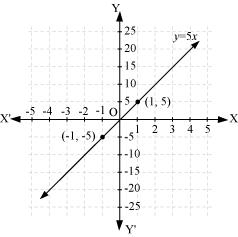
(i)From the graphs, it can be observed that the value of y corresponding to x = 2 is 10. This implies that the work done by the body is 10 units when the distance travelled by it is 2 units.
(ii) From the graphs, it can be observed that the value of y corresponding to x = 0 is 0. This implies that the work done by the body is 0 units when the distance travelled by it is 0 unit.
Q7 : Yamini and Fatima, two students of Class IX of a school, together contributed Rs 100 towards the Prime Minister’s Relief Fund to help the earthquake victims. Write a linear equation which satisfies this data. (You may take their contributions as Rs x and Rs y.) Draw the graph of the same.
Answer :
Let the amount that Yamini and Fatima contributed be x and y respectively towards the Prime Minister’s Relief fund.
Amount contributed by Yamini + Amount contributed by Fatima = 100
x + y = 100
It can be observed that (100, 0) and (0, 100) satisfy the above equation. Therefore, these are the solutions of the above equation. The graph is constructed as follows.
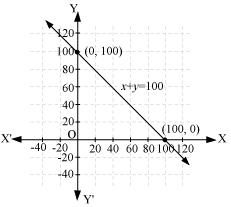
Here, it can be seen that variable x and y are representing the amount contributed by Yamini and Fatima respectively and these quantities cannot be negative. Hence, only those values of x and y which are lying in the 1st quadrant will be considered.
Q8 : In countries like USA and Canada, temperature is measured in Fahrenheit, whereas in countries like India, it is measured in Celsius. Here is a linear equation that converts Fahrenheit to Celsius:
![]()
(i) Draw the graph of the linear equation above using Celsius for x-axis and Fahrenheit for y-axis.
(ii) If the temperature is 30°C, what is the temperature in Fahrenheit?
(iii) If the temperature is 95°F, what is the temperature in Celsius?
(iv) If the temperature is 0°C, what is the temperature in Fahrenheit and if the temperature is 0°F, what is the temperature in Celsius?
(v) Is there a temperature which is numerically the same in both Fahrenheit and Celsius? If yes, find it.
Answer :
(i)![]()
It can be observed that points (0, 32) and ( – 40, – 40) satisfy the given equation. Therefore, these points are the solutions of this equation.
The graph of the above equation is constructed as follows.
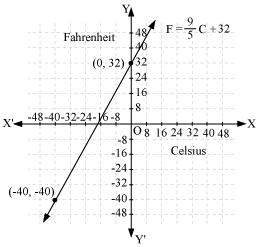
(ii) Temperature = 30°C
![]()
![]()
Therefore, the temperature in Fahrenheit is 86°F.
(iii) Temperature = 95°F
![]()
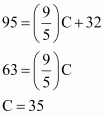
Therefore, the temperature in Celsius is 35°C.
(iv)![]()
If C = 0°C, then
![]()
Therefore, if C = 0°C, then F = 32°F
If F = 0°F, then
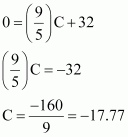
Therefore, if F = 0°F, then C = – 17.8°C
(v)![]()
Here, F = C
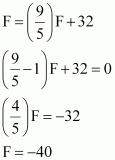
Yes, there is a temperature, – 40°, which is numerically the same in both Fahrenheit and Celsius.
Exercise 4.4 : Solutions of Questions on Page Number : 77
Q1 : Give the geometric representation of y = 3 as an equation
(I) in one variable
(II) in two variables
Answer :
In one variable, y = 3 represents a point as shown in following figure.

In two variables, y = 3 represents a straight line passing through point (0, 3) and parallel to x-axis. It is a collection of all points of the plane, having their y-coordinate as 3.
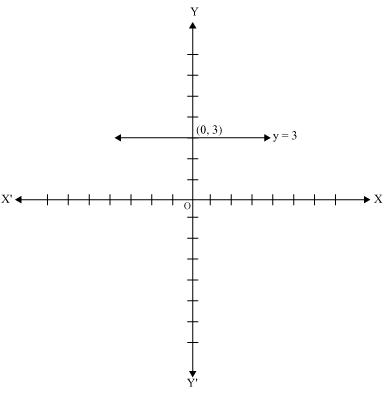
Q2 : Give the geometric representations of 2x + 9 = 0 as an equation
(1) in one variable
(2) in two variables
Answer :
(1) In one variable, 2x + 9 = 0 represents a point![]() as shown in the following figure.
as shown in the following figure.

(2) In two variables, 2x + 9 = 0 represents a straight line passing through point
( – 4.5, 0) and parallel to y-axis. It is a collection of all points of the plane, having their x-coordinate as 4.5.
